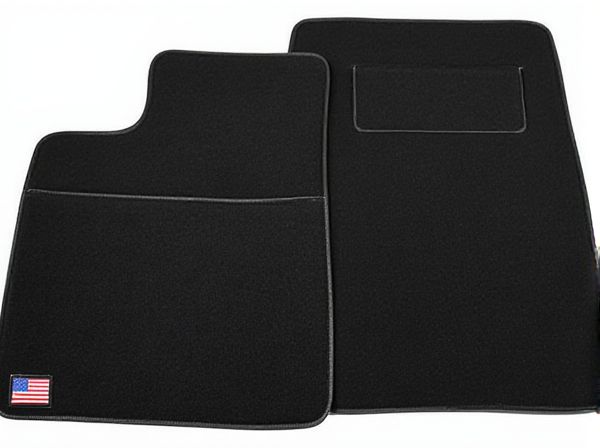
Photo illustration: Mold-Resistant Mat vs Non-Treated Mat
A mold-resistant mat prevents the growth of mold and mildew, ensuring a cleaner and healthier environment compared to a non-treated mat, which can quickly harbor moisture and bacteria. By choosing a mold-resistant mat, you reduce the risk of unpleasant odors, stains, and potential health hazards linked to mold exposure. Your space remains fresher and safer, especially in damp or humid conditions where untreated mats degrade faster.
Table of Comparison
| Feature | Mold-Resistant Mat | Non-Treated Mat |
|---|---|---|
| Mold Prevention | Effective mold barrier, inhibits growth | No protection, prone to mold and mildew |
| Durability | Enhanced lifespan due to anti-fungal properties | Shorter lifespan, degrades from moisture damage |
| Maintenance | Easy to clean, resists stains and odors | High maintenance, retains dirt and moisture |
| Health Impact | Reduces allergens, promotes healthier air quality | May harbor allergens and bacteria |
| Cost | Higher upfront cost, better ROI over time | Lower initial cost, more frequent replacements |
Introduction: Understanding Mold-Resistant and Non-Treated Mats
Mold-resistant mats are engineered with antimicrobial treatments that inhibit mold and mildew growth, ensuring prolonged durability and hygiene in damp environments. Non-treated mats lack these protective properties, making them susceptible to moisture retention and subsequent mold development. Choosing mold-resistant mats enhances indoor air quality and reduces maintenance efforts in areas prone to humidity.
How Mold Grows on Mats: Key Factors
Mold grows on mats primarily due to moisture retention, poor ventilation, and organic material accumulation, creating an ideal environment for fungal spores to thrive. Mold-resistant mats incorporate antimicrobial treatments or synthetic fibers that inhibit mold growth by reducing moisture absorption and preventing spore colonization. Non-treated mats, often made from natural fibers like cotton or coir, absorb water and retain humidity, significantly increasing the risk of mold formation and associated odors.
Material Composition: What Sets Mold-Resistant Mats Apart
Mold-resistant mats are typically made from synthetic fibers such as polypropylene or polyester treated with antimicrobial agents that inhibit mold and mildew growth, enhancing durability in damp environments. Non-treated mats often use natural fibers like cotton or coir, which retain moisture and provide a breeding ground for mold. The advanced material composition of mold-resistant mats offers superior moisture resistance and longevity compared to conventional non-treated mats.
Durability: Longevity of Mold-Resistant vs Non-Treated Mats
Mold-resistant mats feature antimicrobial treatments that significantly enhance their durability by preventing moisture absorption and fungal growth, extending their lifespan beyond that of non-treated mats. Non-treated mats are prone to mold, mildew, and degradation when exposed to damp environments, resulting in frequent replacements and reduced longevity. Choosing mold-resistant mats ensures sustained performance and structural integrity, especially in high-humidity or outdoor settings.
Health Implications: Mold Exposure Risks
Mold-resistant mats significantly reduce the risk of mold growth, which can cause respiratory issues, allergic reactions, and worsen asthma symptoms, making them a safer choice for indoor environments. Non-treated mats are prone to moisture retention, creating an ideal breeding ground for mold spores that pose serious health hazards, especially in humid or damp conditions. Choosing mold-resistant mats helps minimize exposure to harmful mycotoxins and airborne allergens, promoting better indoor air quality and overall health.
Maintenance Requirements: Ease of Cleaning and Upkeep
Mold-resistant mats feature antimicrobial treatments that inhibit mold growth, significantly reducing the frequency and intensity of cleaning compared to non-treated mats. Non-treated mats often require more frequent washing and drying to prevent mold and mildew buildup, increasing maintenance time and effort. Easy-to-clean mold-resistant mats ensure longer durability and maintain hygiene standards with minimal upkeep.
Cost Comparison: Initial Investment vs Long-Term Savings
Mold-resistant mats typically involve a higher initial investment compared to non-treated mats due to advanced antimicrobial materials and manufacturing processes. However, their long-term savings emerge from reduced maintenance costs, fewer replacements, and minimized health risks associated with mold exposure. Over time, the durability and prevention of mold-related damage make mold-resistant mats a more cost-effective solution despite the upfront expense.
Use Cases: Ideal Environments for Each Mat Type
Mold-resistant mats excel in damp, high-humidity environments such as gyms, bathrooms, and outdoor patios where moisture exposure is frequent, preventing mold growth and maintaining hygiene. Non-treated mats are suitable for dry, low-moisture areas like offices, living rooms, and entryways where mold risk is minimal and traditional cushioning or aesthetic appeal is prioritized. Selecting the appropriate mat type depends on environmental conditions and specific use cases to ensure longevity and safety.
Environmental Impact: Sustainability and Eco-Friendliness
Mold-resistant mats reduce environmental harm by minimizing the need for chemical treatments and frequent replacements caused by mold damage, thereby lowering waste and resource consumption. Non-treated mats often require harsh fungicides and more frequent disposal, contributing to environmental pollution and increased landfill burden. Sustainable mold-resistant mats are typically designed using eco-friendly materials that promote durability and reduce the overall carbon footprint in comparison to their non-treated counterparts.
Verdict: Choosing the Right Mat for Your Needs
Mold-resistant mats contain antimicrobial treatments that prevent mold growth, making them ideal for damp environments such as bathrooms or outdoor patios. Non-treated mats lack these protective properties and can harbor mold, leading to unpleasant odors and health concerns over time. For long-term durability and hygiene, mold-resistant mats offer a clearer advantage, but non-treated mats may suffice in dry, low-moisture areas.
 caratoz.com
caratoz.com